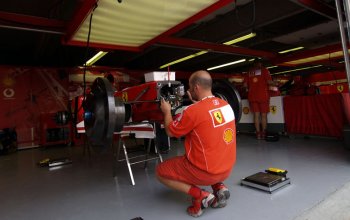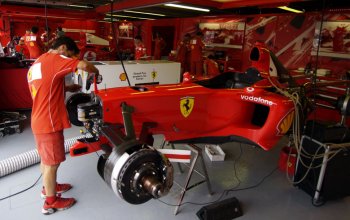|
The eighth round
of the World Championship takes place on the Ile Notre Dame,
an island in the St. Lawrence Seaway, a short subway ride
from the city of Montreal. The location was used for the
Expo 67 world fair and the paddock backs onto a rowing basin
built for the 1976 Olympic Games. Hemmed in on all sides by
water the facilities and the circuit, are rather cramped,
with the barriers very near the side of the track, which
follows the perimeter of the island. This means the race
track has some
very high speed sections, linked by tight ninety degree
corners and a couple of hairpins.
The Montreal
circuit is known for being hard on engines and that will be
particularly applicable this year as Scuderia Ferrari
Marlboro and the majority of other teams will be tackling
the Canadian event with the same engines that have already
gone through a weekend’s use at the Nurburgring. Montreal is
not particularly demanding on the engine in terms of the
percentage of the lap spent at full throttle, while the
longest time spent at full throttle is pretty much the same
as the season average. The stress comes from the fact that
the circuit not only has some of the quickest sections of
the year, it also has some of the slowest, so the perfect
Montreal engine has to be very flexible at all speeds, while
providing plenty of torque to power out of the tight slow
corners.
Those corners
lead to another key element at the “Gilles Villeneuve”
circuit – the brakes. “The fast nature of the circuit means
we run in low aerodynamic downforce configuration, the
lowest of the season apart from Monza,” explains Luca
Baldisserri, Scuderia Ferrari Marlboro’s Head of Race
Engineers. “Because of this we have to brake from very high
speeds of around 340 km/h down to around 60 km/h, so the
speed differential is huge. This is why it is very hard work
for the brakes.”
Unlike road cars
that usually use steel brake discs and an organic pad
material, F1 cars use carbon discs and carbon pads. The
advantages of carbon are that the components are about half
the weight of those made from conventional materials and it
also offers a much higher coefficient of friction and
therefore greater braking force.
The
disadvantages are that the carbon set up requires very high
(over 650 celsius) temperatures to operate properly and that
the discs and pads wear out much more quickly than those
made of conventional materials. This is because wear is
caused not simply by the normal mechanism experienced by
frictional material, but through a process of oxidisation
where the carbon actually burns away. “In Canada, we try
different materials, because we need a lot of bite from the
brakes to stop the car in as short a time as possible,” says Baldisserri. “The standard brakes we normally use at other
tracks are less efficient and different materials can
improve that characteristic. One must not forget the life of
the components, as brake wear is an important factor for
this race. We need to find a good material that gives a lot
of bite but that will still work effectively throughout the
whole race distance."
Canada is also known for being heavy on fuel consumption and
obviously, carrying more fuel adds to the stresses already
placed on the brakes, as a heavier car is harder to stop.
Changes to the qualifying format introduced at the European
GP might have an effect on this, as Baldisserri explains.
|
 |
|
Scuderia Ferrari - 2004
Canadian Grand Prix - Montreal |
|
|
 |
|
Scuderia Ferrari - 2004
Canadian Grand Prix - Montreal |
|
|
"“The rule requiring a driver to complete the race distance
on one set of tyres definitely reduced the number of race
pit-stops in the first part of the season. However at the
Nurburgring, with just the one qualifying session which cars
contested using the fuel for the first stint of the race, we
saw that some people were going back towards a more
aggressive race strategy and stopping earlier as was the
case last year. In Canada some teams might go in that
direction, so as to run a lighter car. Depending on tyre
performance, you can decide to be conservative or
aggressive. Last year in Montreal for example, at Ferrari we
had tyres that were not the fastest in terms of performance
so we decided to go for a two stop race. Qualifying was not
great but it was a successful race for us, with a one-two
finish.”
The whole
braking process is complicated further by the laws of
aerodynamics. When the driver first applies the brakes at
very high speeds, the downforce generated by the car
prevents the wheels from locking up, by pressing the wheels
down onto the track. As the speed decreases so too does the
downforce and therefore the amount of grip from the tyres.
But this lack of grip coincides with the point at which the
brakes are fully up to temperature and are working most
effectively. This means that, when the brakes are at their
best, the car is least able to transmit the braking forces
to the road thus leading to locking wheels and the chance of
skidding off the road.
In order to
prevent this phenomenon, the cars can harness the braking
characteristics of the engine. All 4-stroke engines produce
engine braking when a driver lifts off the throttle, but F1
engineers can harness this ability to meet the specific
needs of any braking situation. “We can modify engine
braking, the amount of braking forces generated by the
engine, during the braking phase,” says Baldisserri. “This
allows us to modulate the rear wheels locking. A lot of
engine braking tends to lock the rear more and we can reduce
that by opening the throttle without the driver having to do
anything, as allowed by the rules. So depending if the front
or the rear is locking up, we can either reduce or increase
the engine braking. If the car is locking the fronts, we
need more engine braking to reduce the amount of normal
braking at the front. This is something the driver can
adjust from the cockpit, in the same way as traction
control, to suit individual corners on the track.”
Although F1
brakes operate at high temperatures, heat is what causes the
brakes to wear out and fail. The brakes are cooled by
forcing air inside and around the discs through ducts at the
front of the car. However, regulations restrict the size of
these ducts and in any case, large ducts affect the car’s
performance in other ways. “You have to find a balance
between cooling the brakes and the car’s overall
efficiency,” maintains Baldisserri. “The brake cooling ducts
have an effect on the aerodynamic efficiency of the car. In
simple terms, the bigger the brake ducts, the worse the
efficiency of the car, so we have to find the right
compromise.” The conclusion
is that, while Formula 1 is perceived as being all about
speed and power, in Canada, being able to stop the car
efficiently is the real secret to a quick lap.
|
|
|
|
![]()
![]()